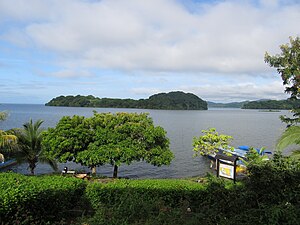Solentiname
| Solentiname | ||
|---|---|---|
| View from the island of Mancarrón to the archipelago | ||
| Waters | Lake Nicaragua | |
| Geographical location | 11 ° 11 ′ N , 84 ° 59 ′ W | |
|
|
||
| Number of islands | 36 | |
| Main island | Mancarrón | |
| Total land area | 40.2 km² | |
| Residents | 1000 (2009) | |
| Map of the archipelago | ||
Solentiname [ solεnti'name ] is an archipelago consisting of 36 islands at the southern end of Lake Nicaragua (also known as Lago Cocibolca ) near the border with Costa Rica .
Geography and population
The archipelago belongs to the department of Río San Juan . This is one of fifteen administrative districts ( departments ) in Nicaragua . The region is named after the river of the same name , which starts at the district capital San Carlos as an outflow from Lake Nicaragua and flows into the Caribbean Sea almost 200 kilometers further east at San Juan del Norte (at the time of the English conquerors Greytown) .
The archipelago consists of the four large main islands (from west to east) Mancarroncito , Mancarrón , San Fernando and La Venada and 32 rugged smaller islands 10 to 30 kilometers west of the city of San Carlos. The archipelago is of volcanic origin, the highest point on the island of Mancarrón is 257 meters above sea level and thus 226 m above the water level of the lake. Solitude and scenic beauty have attracted many artists. Painters and sculptors share the islands with farmers and fishermen. A total of about 1000 people live on the 38 km² of the archipelago. Amenities such as running water and electricity are relatively rare.
On the largest island of Mancarrón , the poet , politician and priest Ernesto Cardenal founded a monastery-like Christian cooperative in the second half of the 1960s. Solentiname became famous in Germany through his book "The Gospel of the Peasants of Solentiname". His artistic social project from the early 1970s still exists today. The inhabitants of the island developed their own artistic point of view - a kind of naive painting - which was based on existing folkloric elements. Artists like Róger Pérez de la Rocha supported this movement.
There are different opinions about the origin of the name Solentiname . Some believe that it means "quail hedge" in Nahuatl . Others claim that the name comes from the Nahuatl term Celentinametl and means something like "place where many guests gather".
Climate, flora, fauna
The climate is tropical and the annual rainfall varies between 1400 and 1800 mm. The rainiest season is between May and December. The average temperature is 26 ° C. Numerous bird species are native to the islands ( parrots , toucans ). The waters around the islands are rich in fish. There are deer and roe deer on La Venada ( Spanish venado for "stag"). Agricultural production focuses on cotton , sesame and corn .
There are also archaeological finds on the archipelago that are worth seeing: The rock carvings of San Fernando show pictures of parrots, monkeys and people. In a nature reserve, the Los Guatuzos Wildlife Refuge , you can watch monkeys and alligators .
Web links
- Web presentation of a community of Solentina names (English, French, German, Spanish, archived version)
- Art from Solentiname (Spanish)
- Photographic impressions (French)
- Art and wildlife of the archipelago (Spanish)


